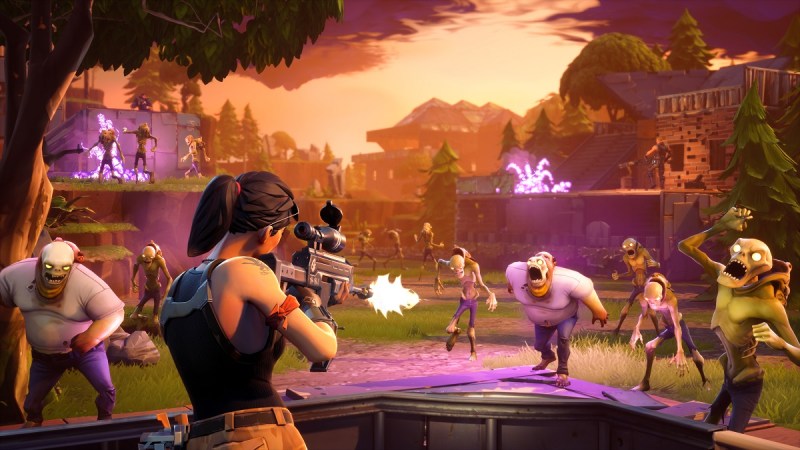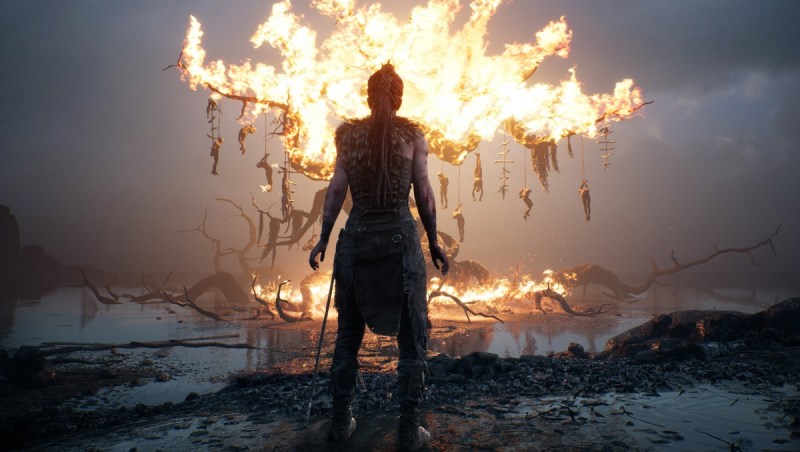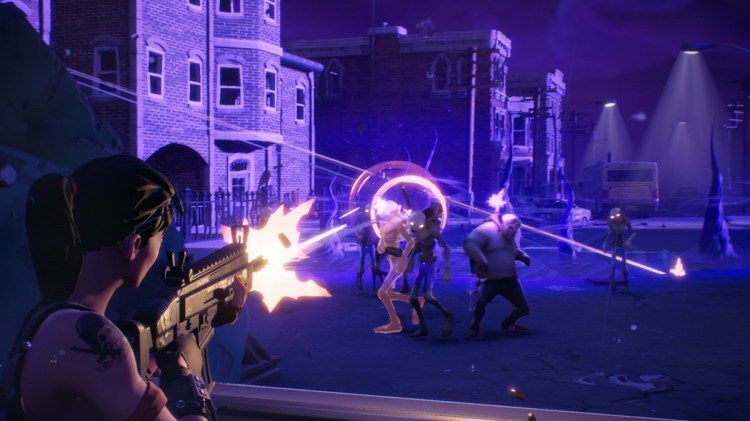
Above: Senua is an ordinary character, except for the blue tattoo.
GamesBeat: I finished playing Hellblade. That was outstanding.
Sweeney: It’s amazing. It’s one of the best-looking games ever created.
GamesBeat: It speaks to what you were saying about digital humans. I didn’t find any fault with those images.
Sweeney: There’s an incredible amount of talent out there. Recognize that most of that data was motion-captured in real time using this new hardware. Now extrapolate three years ahead. Maybe your typical VR and AR headset will be able to do that same level of motion capture, instead of a $10,000 rig for game developers. Imagine that technology is available to everyone. It’s happening fast.
GamesBeat: Were you satisfied with the results there, or do you feel like it still has some distance to go to be as perfect as it could be?
Sweeney: I think it’s ready for prime time. It’s proven out, many times now. It’s only going to get better over the years, especially as we introduce more logic into reconstructing facial motion from these video signals being fed in. Soon you’ll have the ability to do that without any preparation – without markers on on the actor’s face, for example. It’ll improve by leaps and bounds.
GamesBeat: You still need an artist to stylize it in some way. The original The Lord of the Rings had some of that, where they tried to make the orcs look real, but they still looked a lot like people wearing orc makeup.
Sweeney: Faces are the hardest problem in computer graphics. Your brain has such hardwired expectations of what they do.

Above: The Smasher is a tough enemy in Fortnite.
GamesBeat: You guys launched Fortnite. How has that turned out?
Sweeney: It’s on track to be Epic’s most successful game ever by the end of the year. Several times more users than we expected came in. We had to really scramble to keep the servers running at that scale. It was great experience. This is just the very beginning. We have a bunch more game modes coming, which should be interesting and innovative. The whole aspect of building in Fortnite creates a really different dynamic compared to most games. Building structures, defending them, you can imagine all the multiplayer implications.
We’re very happy with the transition we’ve been making, from being a lone developer who works with a publisher and puts games on retail store shelves to running our games live as services where we can constantly improve the game based on feedback. It’s been a great step. Fortnite is getting better every week.
GamesBeat: The early access on that one at some point converts to free-to-play, right?
Sweeney: Yeah, at some time next year we’ll go completely free.
GamesBeat: It almost seems like a paid game, just the way so many people are piling in to early access.
Sweeney: It’s an area where developers have a lot of territory to explore. Early access is one option. Free-to-play is another option. There’s a wide range of possibilities. It’s expensive to build a game on this scale now, and it’s imperative that we find ways we can pay it off.

Above: Fortnite is a zany take on defending forts against zombies.
GamesBeat: Was Fortnite a lot more expensive to build than, say, the first Gears of War?
Sweeney: Much more expensive. What we saw over the last generation — the economics started out incredibly attractive. The first Gears of War game cost about $12 million for Epic to make and earned us more than $100 million. But by the end of that generation, the costs had blown up to almost equal the profit a game could make. At this point, in this generation, I don’t know how you make a game at the triple-A level unless you sell 12 million copies or more. The teams are hundreds of people, sometimes more than 1,000. Budgets are more than $100 million, sometimes several hundred million. The scale of sales needed to justify that is crazy.
It’s awesome to see so many different games of different sizes being built. Everything from Astroneer, which was number one on Steam and built by six people, to PlayerUnknown’s Battlegrounds, which is not a huge team. Indies can succeed with great games at any scale. We’re constantly reminded of that. The only thing all great games have in common is fun. Anything from Angry Birds to Grand Theft Auto, they all provide fun in a different way. There’s a 10-person version of a fun game and there’s a 1,000-person of a fun game, and they both work.
GamesBeat: Do you think some of these very successful free-to-play efforts might be useful to finance other big things? Say that 1,000-person project is kind of iffy, but you want to do that to push the state of the art. Something like Game of War can make a billion dollars. Why not use that to finance the big game?
Sweeney: Absolutely. We need to be constantly exploring business models that work. As the industry evolves, business models change. Epic’s survived through a number of different ones over our history, from shareware to PC retail to big-budget triple-A console and back to indie, publishing our own games for ourselves. You have to constantly change the rules.

Above: Real or madness? It’s all-too real for Senua in Hellblade.
GamesBeat: VR seemed to cool off a bit in the last few months, and esports investments are picking up. Do you see something happening there?
Sweeney: There’s definitely a lull in VR right now. After the initial wave of sales, Oculus and HTC don’t seem to be making a whole lot of new business. We’ll see what happens next. I hope we see a new wave of VR hardware that substantially updates the spec and improves the visual quality through higher resolution and better optics, and improves the accessibility by making things easier to set up. At some point we’re all going to need to move to inside out tracking so you don’t need to set up a bunch of cameras around the room, and that will be more user-friendly.
Every step we make is a significant iteration toward a better product. Miniaturizing the technology so it’s more toward being glasses and less toward being a helmet.
GamesBeat: People are saying we’ll have to get things like 5G in place before some of this is possible.
Sweeney: There’s also ARKit now, augmented reality that reaches more than 100 million iOS users. That’s going to be a huge frontier for developers of these types of games. That’s a huge user base, and we’re just in the early days. We’re going to see entirely new genres of games invented over the next year that take advantage of AR in entirely new ways.
Disclosure: The organizers of Devcom paid my way to Cologne. Our coverage remains objective.

